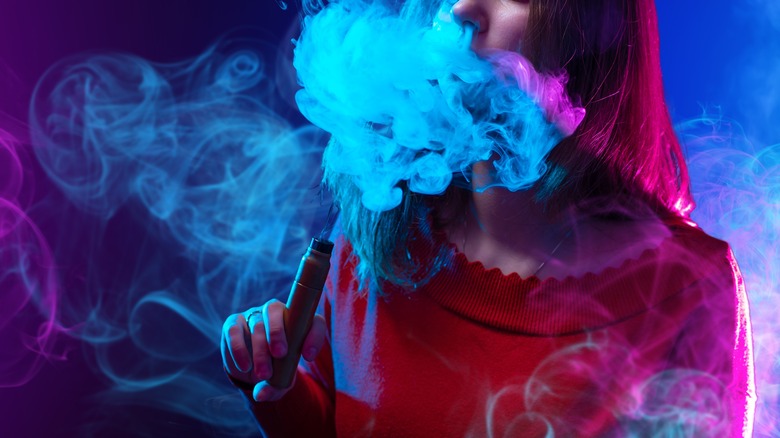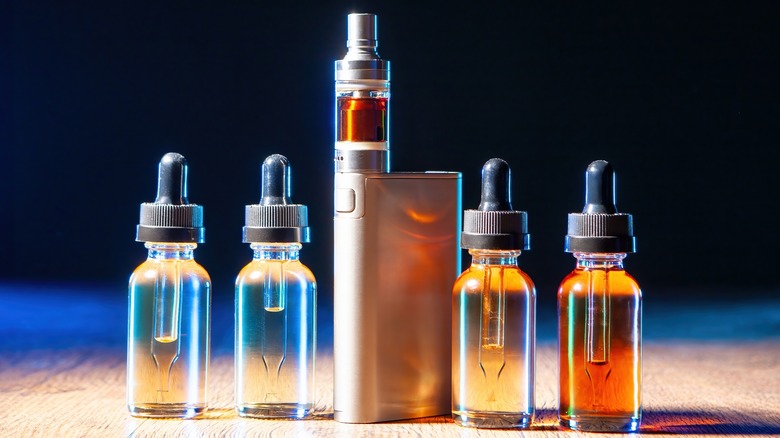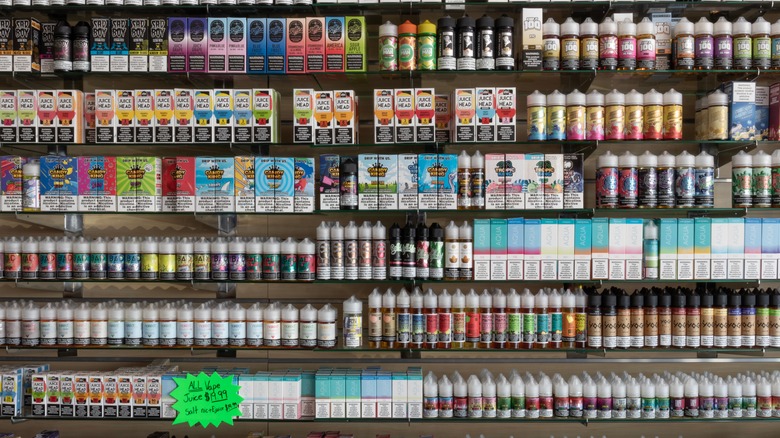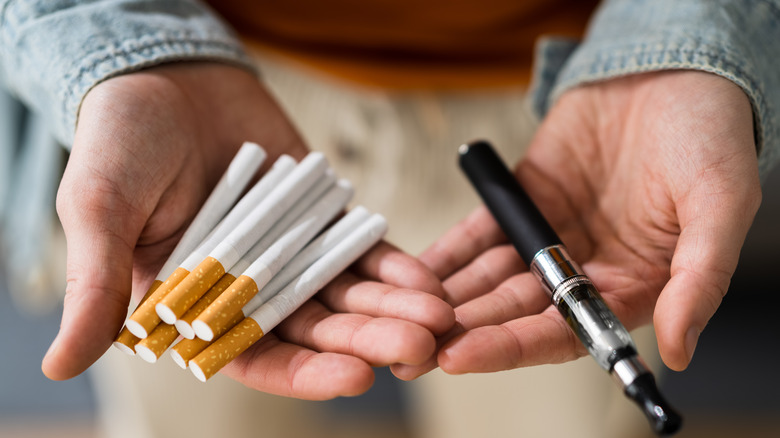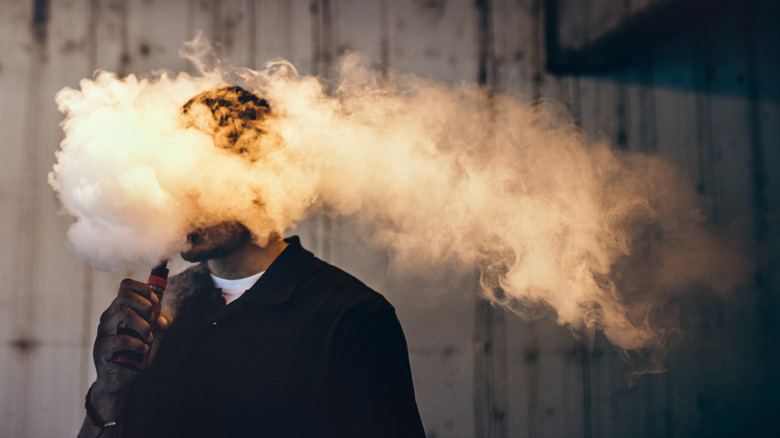Weird Vaping Facts You May Have Overlooked
Marketed as a cool, less lethal alternative to cigarettes when they hit the North American market in 2008, e-cigarettes have taken off in a big, big way. By 2020, one in five high schoolers in the United States smoked vapes, which by 2022 equaled 2.5 million people countrywide. One in four smoked every day at that point, and 85% of them smoked flavored products other than straight-up tobacco. The tobacco industry has marketed heavily toward getting people hooked on vapes, especially younger people. As the International Journal of Environmental Research and Public Health reports, 56.3% of vape posts on Instagram in 2016 were marketing ploys, as compared with only 1.3% of traditional cigarette posts.
With so many people sucking down vape fumes and puffing out silky white clouds, the question begs: What the heck is actually in these things? What are people filling their lungs with? Are they safe? Dangerous? How do they even work? Where did the product even come from?
Some folks might be able to recount the e-cigarette basics, which Dr. Markus Nordlund at Philip Morris goes over on YouTube. In a nutshell, regular cigarettes combust ingredients using fire at a high temperature, which produces liquid and solid particles suspended in gas, i.e., smoke. E-cigarettes heat ingredients at a low temperature, which produces liquid only in gas, without the solid particles (mostly), i.e., an aerosol. Beyond that things get complicated, and if not completely bizarre, definitely unexpected.
Inhaling fumes like it's ancient Egypt
At its core, e-cigarettes are a modern version of something that humans have been doing since forever: inhaling nice-smelling aromas. The International Federation of Aromatherapists says that folks in ancient Egypt soaked cloth in fragrant oils and then heated the cloth to inhale the fumes (i.e., "maceration"). They also used fragrances for massages, in skincare products, and of course, for embalming the dead. The Greeks inherited this knowledge and then passed it along to ancient Rome. And of course, anyone who's been to India or countries like Thailand or Vietnam can tell you that incense is everywhere and has been a part of life for hundreds, sometimes thousands of years. And let us not forget hookahs, which pass hot tobacco smoke through water.
E-cigarettes might not be exactly the same as all of those inhalation methods, but they do share a similar basic principle and process of heating something to produce pleasant fumes. CASAA says that the first electronic cigarette patent was filed in 1927, although the specifics are unclear. The first recognizable e-cigarette prototype came later, following yet another 1965 patent by one Herbert A. Gilbert. But, it took until the 1990s when R. J. Reynolds Tobacco Company created the first "heat-not-burn" non-combustible e-cigarette. Attempts to bring such products to market in 1998 got blocked by the FDA on the grounds of being an "unapproved drug delivery device," which marked the beginning of a steep uphill battle toward widespread legalization and commercialization.
An uphill legal battle
When we say that vaping faced an uphill battle, we're talking about a decade of legal back and forths, scrutiny by health organizations, scientific studies, and more, as CASAA outlines. In fact, even today, as Royal Flush Vape shows, vaping is not universally legal worldwide. In the United States, Canada, and most European countries vaping is legal but restricted by age, which in most countries is 18 but in the U.S. is 21. Some countries like Japan, Malaysia, and Norway have banned e-cigarettes only if they contain nicotine. Many South American and Middle Eastern countries have banned them entirely, and in a few countries like India, Taiwan, and the Philippines people face imprisonment for using them. Other countries have no laws whatsoever about vaping.
As CASAA reports, some governments were late to the regulation game, like Turkey, who suspended the sales of e-cigarettes in 2008 before concluding that they were "just as harmful as regular cigarettes." The World Health Organization conducted a study that same year and stated that e-cigarettes were not effective tools to help quit smoking. In 2009 Australia decided that "every form of nicotine except for replacement therapies and cigarettes are classified as a form of poison." From 2009 to 2010 various vaping companies, anti-tobacco groups, the FDA, and more in the United States locked horns over e-cigarettes, and some companies like NJOY even altered their products to fit with legal constraints by limiting flavors to "traditional tobacco" and menthol.
Black tar or black market
And so we come to question of the chemical concoctions found within e-cigarettes. Regular cigarettes, as the American Lung Association cites, contain up to 600 ingredients, which when burned produce a mind-blowing 7,000 ingredients. Many are toxic, and 69 are known carcinogens, including arsenic (rat poison), cadmium (used in car batteries), ammonia (a household cleaner), and tar (in pavement). E-cigarettes may not be as bad as this, but they're also not as benign as aromatherapy diffusers.
On one side we've got the Surgeon General, who says that e-cigarette aerosols still contain solid particles like nickel and lead, or else "ultrafine particles" that don't belong in anyone's lungs. The Surgeon General also mentions diacetyl, a chemical response for the horrifyingly named condition "popcorn lung," aka bronchiolitis obliterans, a condition that causes a narrowing of fine passageways in the lungs. The U.K.'s National Health Service (NHS) says that this is a myth, however. Meanwhile, Vaping 360 points to flavor-producing chemicals like propylene glycol and vegetable glycerin as potentially harmful.
Truth Initiative points to nicotine as the obvious dangerous chemical and says that the type of e-cigarette (vape pen, vape pod, box mod, etc.) affects how the body receives the drug. Imprecise product labels compound this problem, as do black market vaping products, per the Vape Superstore. In a survey, the Vape Superstore found that 83.4% of respondents didn't know the health dangers of illegal vapes, and 34.1% didn't know the difference between legal and unregulated products.
Gateway drug, not cessation drug
Because nicotine is still the primary chemical in most e-cigarettes — and if not, potentially dangerous flavor-producing chemicals (per Vaping 360) — one has to wonder: How helpful is vaping at reducing nicotine dependency? Robert H. Shmerling, MD, at Harvard University has a simple answer that depends on whether or not someone is already a smoker. "For nonsmokers and teens, there is no controversy: don't start smoking and don't vape," he says. This is because not only does nicotine have an extra detrimental effect on developing brains, but e-cigarette usage can actually encourage cigarette usage later on. For those who understand the escalating nature of drug and alcohol addictions, this won't come as a surprise.
For adult smokers, Dr. Shmerling says, "be aware that the balance of risks and benefits and the long-term health consequences of vaping are uncertain." Nicotine use not only encompasses obvious effects like cancer, but lung disease like emphysema, asthma, and chronic obstructive pulmonary disease, as well as heart disease, reduced appetite, increased blood pressure, nausea, and more. And as Penn State says, addictions happen even at low levels of nicotine; one-quarter of those who smoke cigarettes only once per week still qualify as addicted.
And yet, the NHS comes down on the side of supporting vaping, at least for those who are actively trying to quit smoking. E-cigarettes are more effective than patches or gum, the NHS says, especially because they simulate the "throat hit" of cigarettes.
'Wellness vaping' is a thing
And so we come to arguably our strangest piece of vaping info: "wellness vaping." As The Guardian reports, some companies have already moved beyond questions of e-cigarette safety to say that e-cigarettes are a type of holistic health product, i.e., "nutritional supplement diffusers." Doses of vitamin B12, melatonin, essential oils, companies with names like Inhale Health and Nutriair, proclamations like (per the FDA) "fight off tumors," "organic asthma remedy, ADHD remedy, dementia treatment," "helps prevent a type of anemia," "treatment against anxiety and depression:" Now customers have to sift through all such disingenuous snake oil tactics. Is that an unfair statement? Not according to the FDA, who bluntly says: "These claims are unproven, and the products may be ineffective, a waste of money, unsafe, and may prevent or delay you from seeking an appropriate diagnosis and treatment from a health care professional."
The problem, as always, rests in untested ingredients. "Wellness vaping" options are non-nicotine in nature, which as The Guardian explains means that they include the same potentially harmful chemicals we mentioned before, like propylene glycol and vegetable glycerin. Irfan Rahman, Professor at the University of Rochester Medical Center, plainly says in The Guardian, "Lungs are meant for oxygen and not for these complex chemicals." Similarly, Dr Gregory Ratti, a pulmonologist at the University of Texas Southwestern Medical Center in Dallas, says, "If those are going into the lungs that is worrisome." All in all: Think twice before inhaling weird chemicals into your lungs.
